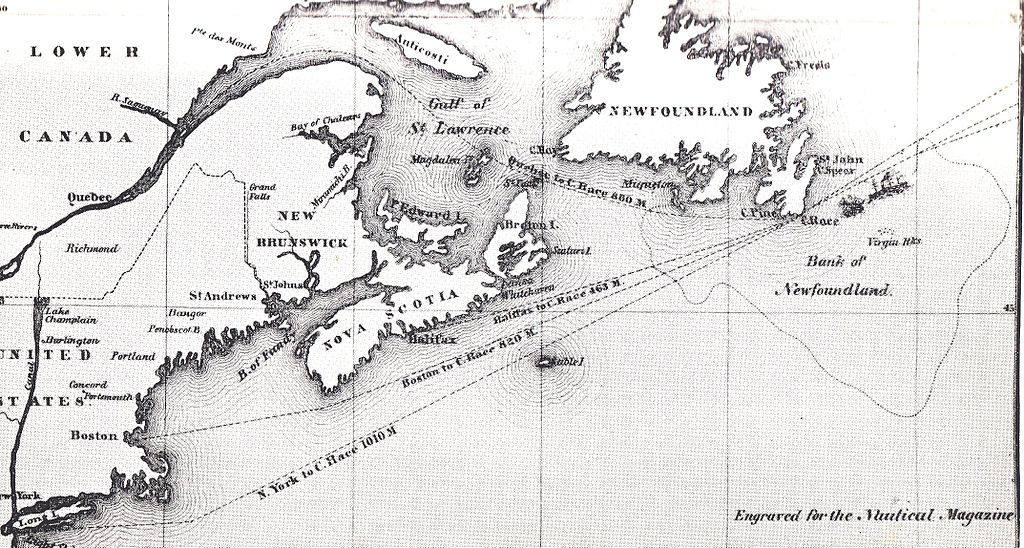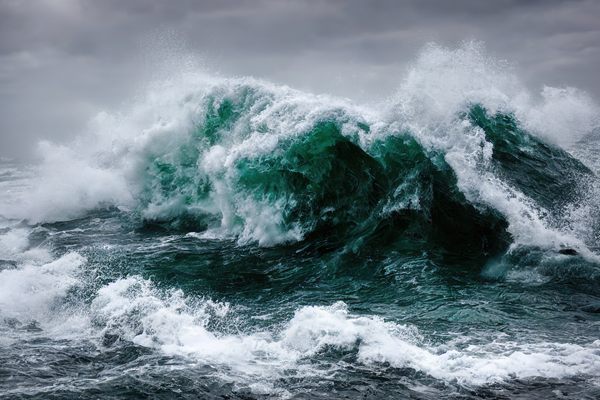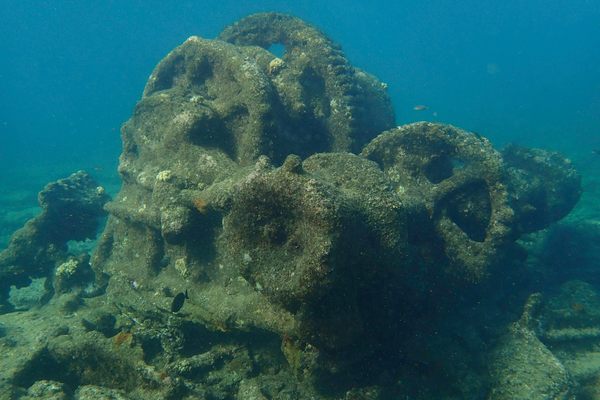When the World’s Biggest Ships Meet the World’s Skinniest Straits

MSC Oscar, the world’s largest container ship (Photo: MSC OSCAR & SVITZER NARI/WikiCommons CC BY-SA 2.0)
On the morning of March 22, 2014, the coast of Galveston, Texas, was covered in fog. In this port city, huge ships regularly glide by each other through narrow slips of water, but this morning the visibility was so low, pilots had stopped boarding their deep draft vessels. As the fog began to clear, though, the Miss Susan started moving, with two barges loaded with 1.9 million gallons of fuel oil in tow behind it.
The boat’s captain, Kelli Hartman, was headed through an area called the Texas City Y, where a few channels meet and ships pass between Galveston and Goat Islands, connecting the ports to the Gulf of Mexico. She knew the Summer Wind, a 607-foot-long bulk freighter, was out there, even if it was still too foggy to see. Although her boat was relatively small—just 70 feet in length—the barges behind it stretched another 600 feet. But, as she later testified during a government investigation, she had calculated that she had plenty of time to cross.
When she looked back at her Automatic Identification System, which automatically tracks the location of nearby ships, she saw, though, that the Summer Wind was speeding up. At 12:31, Hartman got in touch.
“How do I look to you on your plotter?” she asked.
“Well, if you keep on going, I’m gonna get you,” replied the Summer Wind’s Captain Mike Pizzitola. “Because right now I’m less than three quarters of a mile from you.”
“Alright, well, shit, I’m glad I called you here,” Hartman said. The two ships began to negotiate. Could the Summer Wind cut back? It could, “but that still ain’t gonna stop her,” Pizzitola said. The ships were already too close to each other. They were on course to collide.
“I don’t know what to tell you cause, man, it’s close,” Pizzitola said.
“I’m backing her hard, Captain,” Hartman said.
“Keep on doing it, skipper, keep on doing it.”
“I’m looking at you now, and it don’t look good.”
“Yeah, it don’t look good. You need to keep on backing it down as hard as you can…”
At 12:35, the Summer Wind collided with one of the barges the Miss Susan was towing.
Both the Summer Wind and the Miss Susan, counting the barges, were longer than two football fields. When vessels like this run into each other, it looks almost like it’s happening in slow motion, the giant hulks floating inexorably towards each other. Even if they’re moving slowly, these ships have such bulk that they’re difficult to stop: A large ship might need more than 2 miles. And as ships keep getting bigger and the stakes keep getting higher, the question becomes not why did this collision happen, but why don’t more ships collide? What is keeping these giant vessels in their invisible lanes?
In the past decade, the ships that make up the network of global economic trade have become gigantic—both in their maximum size and in the number of boats. The largest ships plying the oceans now can be as long as four football fields, and can carry twice as much cargo as just 10 years ago. In the past 50 years, according to the insurance company Allianz, the carrying capacity of cargo ships has increased by 1,200 percent.
The world’s shipping fleet numbers more than 100,000; in 2014, the industry lost 75 large ships, mostly to “foundering”—sinking—but also to groundings and fires. From 2005 to 2014, there were 1,271 ships lost; 113 of those losses were directly related to collisions. Not all collisions lead to losses, just as not all car crashes total the car: the collision between the Summer Wind and the Miss Susan led to two injuries and 168,000 gallons of spilled oil, but not to the loss of the ships. Shipping’s still a relatively dangerous profession to be in, but since 2005, losses have decreased by half, and while a century ago, every 1 out of 100 ships sunk, now it’s only 1 out of every 670.
Keeping the world’s oceans safe requires new regulation and specialized technology, as more and more giant ships move through the ocean. Once, it seemed like there was so much space in the world’s waters that ships didn’t need any system avoid collisions. But that changed on another foggy day, in 1854.

The position of collision between the ships Arctic and Vesta (Image: Public Domain/WikiCommons)
The SS Arctic was a good ship. When it was built, it had been subsidized by the U.S. government, which wanted an American ship that could carry mail across the Atlantic at least as well as the dominant British fleet. And the Arctic had delivered: It had crossed the Atlantic, heading east, faster than any other ship in the world. It was a paddle steamer, with a wooden hull and a wheel on its side, and could carry 280 passengers and 150 crew members. When it left Liverpool, in September of 1854, it was packed full with both people and cargo.
The crossing of the Atlantic went smoothly enough, but as the Arctic skirted the Newfoundland coast, on its way to New York, a heavy fog descended. It was impossible to see more than three-quarters of a mile away, and then, all of a sudden, another boat—the Vesta—appeared. The Arctic went hard starboard. But it was already too late: the bows of the two boats collided.
Normally, as the larger ship, the Arctic would have had the better of a crash. But the smaller Vesta had an iron hull, and made it back to port. The Arctic went down, and in the chaos, the crew pushed ahead of passengers into the lifeboats. Even the captain, who went down with the ship, survived, but 322 people—mostly passengers—died.
This crash is usually pinpointed as the moment when the public first starting thinking about regulating shipping. In the newspapers, editorials called for more lifeboats, and better ways of moving people off of sinking ships. But the US Navy and the Hydrographic Office’s Bureau of Navigation cited the crash as a reason to create sea lanes—known paths that ships would follow, in order to avoid crashing into each other.
“Men inquired of each other if science or ingenuity could not advise means or invent plans for preventing the recurrence of similar accidents, or, in the case of their recurrence, of providing against the terrible loss of life which attended the foundering of that noble ship,” an 1873 government report explained. Of “those plans which tend to prevent accident…the lanes were most inviting.”
It took decades, though, for anyone to agree on how international shipping lanes would work. For the most part, the ships moving around the globe don’t see each other. Even today, in the open ocean, “the density of traffic is probably more comparable to car traffic in Inner Mongolia or the Sahara,” says Volker Bertram, an engineer and expert for DNV GL, a maritime research and consulting firm. In the late 19th century, mostly the government left the decisions about how ships moved up to the private companies that dominated the sea (with a little nudging). It took until 1889 to create an international agreement on how ships should communicate with each other, and it wasn’t until 1898 that five large transatlantic shipping companies voluntarily signed onto an agreement that created sea lanes.
These lanes, which have been updated since then, change somewhat seasonally and, though they’re tied to weather and currents, as a rule, they’re simply the shortest route between ports. Although sea lanes are useful, in modern shipping, the more pressing problem is what happens when the ships come closer into ports or pass through narrow straits, where congestion begins to build up. Then, the ships need to watch out for each other.
There are certain spots in the world where shipping traffic becomes more problematic than others. Just three maritime regions, Allianz found, accounted for almost half of the shipping industry’s losses between 2005 and 2014—the waters around South China and Indonesia; the eastern Mediterranean and Black Sea; and the region around Japan, Korea, and North China.
“Think of it as driving on busy congested urban commuter routes or open country roads. You have a lot more traffic accidents on the Long Island Expressway or the DC Beltway than I-40 in Arizona,” says Captain Andrew Kinsey, a senior marine risk consultant for Allianz. “The combination of deep sea shipping traffic, combined with coastal traffic and the fishing fleets can create very confusing traffic situations. Combine that with confined waters, less room to safely maneuver, and you have an increase in loss.”
Shipping’s a much older form of transportation than cars or planes, but it’s lagged behind those more modern modes in organized traffic management. There is, for instance, a type of vessel traffic system that’s analogous to air traffic control, but right now it’s not standard at every port in the way that air traffic control is a feature of any airport. It wasn’t until the 1960s that the most congested waterways started introducing “traffic separation schemes” to create clear navigational paths for ships. (The first one was in the Dover Strait, the narrowest part of the English Channel.) And it wasn’t until 1972 that the International Maritime Organization, the U.N. agency responsible for maritime safety, created a set of rules specifically aimed at preventing collisions at sea.
Around the same time, the shipping industry first started relying more heavily on technology that identified that location and speed of ships to keep them safe. Automatic radar plotting aid (ARPA) was developed in response to yet another ship collision on a foggy day; the Automatic Identification System, which depends on ships within a short range broadcasting data to each other, came along in the 1990s (but wasn’t required until the early 2000s). Since that time, as well, there have been commercially available collision avoidance systems—but those aren’t required for all ships, and not all have them. “A lot of people don’t buy them,” says DNV-GL’s Bertram. Think of it in a car context, he suggests: “If we were to make seat belts optional, would people pay to add them?”
Essentially, these technologies increase the number of navigational tools available to people steering ships. But they’re far from foolproof. In the collision between the Summer Wind and the Miss Susan, AIS gave some warning that a problem was developing but didn’t prevent the collision altogether.
“The old adage that was continually repeated to in my training was: The prudent mariner will not rely solely on any single aid to navigation,” says Allianz’s Kinsey.
The 2014 collision between the Richmers Dubai and the Walcon Wizard, a crane barge, in the Dover Strait Traffic Separation Scheme is widely seen as an example of why electronic navigation aids aren’t enough. Just before 2 a.m., on a January night, the officer of the watch on the Richmers Dubai was depending on AIS to guide him around the Kingston, the boat towing the barge. But neither that boat nor Walcon Wizard were broadcasting over the system. The Richmers Dubai plowed into the barge and caught the towline, and began towing the Kingston, stern first, down the strait. The problem here was simple—the officer of the watch had not been keeping a proper lookout, the subsequent investigation found. If he had relied on simpler tools—his eyes—the collision would likely have been avoided.
Still, the shipping industry is looking towards increasing its dependence on automatic navigation technology. This past year, the IMO completed an “e-navigation Strategic Implementation Plan” that aims to improve the use and integration of systems like AIS and ARRA with electronic charts and improve the exchange of data between ships. Already, in the past century, crews have shrunk from hundreds of people down to a few dozen—one person can run a ship’s bridge. If driverless cars are the future of the road, driverless ships are part of the future of the high seas. DNV-GL has developed a concept for a unmanned, zero-emission vessels that could move along the coast autonomously and it’s only a matter of time before a ship without a crew takes to the water.
In the immediate future, though, avoiding collisions in shipping will mean relying on a combination of human judgment and increasingly accurate navigation technology. “We also have to accept that there is no 100 percent of guaranteed safety,” says Bertram. “Not in cars, not in airplanes, not in shipping.” In shipping, as the actual vessels become Hulk-like, there may be ever more cargo at risk, but, with shrinking crews, fewer lives in danger—ultimately, shipping is safer than it’s ever been, and only getting more so.















Follow us on Twitter to get the latest on the world's hidden wonders.
Like us on Facebook to get the latest on the world's hidden wonders.
Follow us on Twitter Like us on Facebook